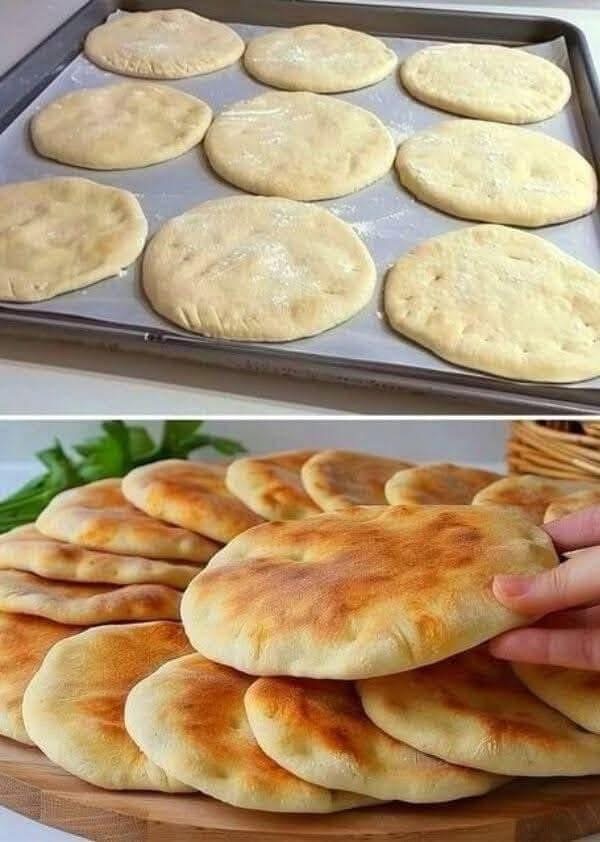Pita bread is one of the simplest and most versatile breads you can prepare at home. Its soft texture, subtle flavor, and golden exterior make it a favorite across kitchens around the world. Whether you enjoy it stuffed with grilled meats, paired with hummus, or served warm with soups and salads, homemade pita tastes significantly better than store-bought varieties. It stays fresher longer, uses wholesome ingredients, and has a wonderfully light texture that commercial versions often lack.
One of the best things about pita bread is how beginner-friendly it is. Even if you have never made bread before, this recipe guides you through easy steps that require minimal effort and no complicated tools. A mixing bowl, baking tray, and a bit of patience are all you need. The dough itself is soft, smooth, and very forgiving, making the process pleasant and rewarding.
The secret to perfect pita bread lies in the dough’s hydration and resting time. Allowing the dough to rise properly creates the airy structure that gives pita its softness. When the dough relaxes during resting, it becomes easier to shape and creates a more even bake. Many people think pita must puff dramatically in the oven to be successful, but this version focuses on softness rather than the traditional pocket. Instead of a fully hollow pita, you get thick, fluffy rounds that are ideal for dipping, spreading, or sandwich-style recipes.
To prepare the dough, begin by mixing warm water with a bit of sugar and yeast. This activates the yeast and ensures your dough rises beautifully. After a few minutes, the mixture becomes foamy and ready to use. Adding flour, salt, and oil creates a smooth, elastic dough. Kneading is essential for developing the gluten structure that keeps the bread soft and stretchy. Even five to seven minutes of kneading by hand is enough to achieve the ideal texture.
Once the dough is ready, it needs time to rise in a warm place. This rising period allows the yeast to work, producing air bubbles that create the bread’s soft interior. When the dough doubles in size, it becomes light and easy to handle. Dividing it into equal pieces ensures consistent results. Each dough ball should be rolled gently into a round shape, thick enough to stay soft but thin enough to bake evenly.
After shaping, the dough balls rest again for a short time. This second rest is important because it relaxes the gluten and prevents the dough from shrinking while baking. It also contributes to the soft, pillowy texture of the final product. When ready, the pitas are arranged on a baking sheet lined with parchment paper. A light dusting of flour prevents sticking and gives the tops their rustic appearance.
Baking pita bread in a hot oven is essential. High heat creates steam inside the dough, helping it rise quickly and giving the bread its distinctive softness. As the tops turn golden, the aroma fills the kitchen and signals that the pitas are ready. Once removed from the oven, they should cool slightly before handling. This makes them even softer and easier to stack.
One of the best parts about homemade pita is its versatility. These soft rounds pair beautifully with a variety of foods. Serve them alongside hummus, baba ganoush, or garlic sauce for a flavorful dip. Pair them with grilled meats like chicken shawarma or kefta for a hearty meal. They also work wonderfully as a base for mini pizzas or breakfast sandwiches. Even simply spreading butter or honey on a warm pita makes a delicious snack.
Storage is simple as well. When cooled completely, these pitas can be placed in an airtight container or zip bag and kept at room temperature for several days. For longer storage, freezing is highly effective. When reheated, they retain their softness and fresh flavor. Warming them briefly in a skillet or oven brings back their just-baked texture.
Making homemade pita bread not only elevates your meals but also gives you full control over the ingredients. No preservatives, no artificial flavors—just simple, wholesome components that create delicious results. For anyone looking to add fresh bread to their weekly routine, this recipe is a wonderful place to start.
Below is a list of ingredients you can include in your WordPress recipe box:
Ingredients:
2 ½ cups flour
1 cup warm water
1 tablespoon sugar
1 teaspoon salt
1 tablespoon oil
1 packet active dry yeast
This homemade pita bread will quickly become a favorite in your kitchen. With its soft texture, warm aroma, and delightful golden color, it’s the perfect addition to everyday meals and special occasions alike. Whether you’re preparing a family dinner or hosting guests, freshly baked pita bread adds comfort, flavor, and authenticity to the table. Enjoy the satisfaction of making your own bread from scratch, and savor every warm bite.
